| |
Glendale |
San Diego |
Glendale |
Austin |
Seattle |
Houston |
| Time Played |
80 | 80 | 65 | 59 | 80 | 80 |
| Tackles |
13 | 12 | 9.5 | 4 | 12 | 4.5 |
| solo |
11 | 10 | 9 | 3 | 10 | 4 |
assist |
4 | 4 | 1 | 2 | 4 | 1 |
| missed |
4 | 2 | 0 | 1 | 4 | 1 |
| completion rate |
76% | 86% | 100% | 80% | 75% | 82% |
| Hurries |
0 | 1 | 2 | 1 | 2 | 1 |
| Rucks |
5 | 3 | 0 | 2 | 2 | 0 |
present |
3 | 3 | 0 | 2 | 2 | 0 |
| jackaled |
2 | 0 | 0 | 1 | 0 | 0 |
Turnovers Forced
(excl. jackaled) |
0 | 1 | 0 | 1 | 0 | 1 |
Even though Paul Lasike
‘was pretty much born with a rugby ball in his hand’,
he’s played football long enough for the sport to leave its mark on his individual technique and mechanics. I have a strong impression that football has affected his tackling the most.
He hits the ball carrier in a similar way inside linebackers do, accelerating and launching himself into the opposing player. Here’s a good example of a linebacker-like tackle from the
test match against Scotland. Lasike pursues Stuart Hogg, stays on a perfect pursuit lane, accelerates, gets impressively low, and delivers a hit.
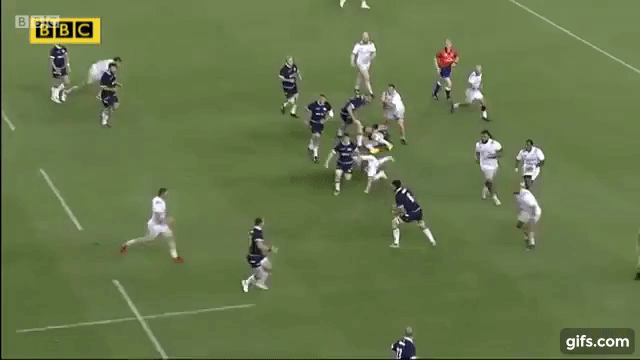
Here’s another spectacular angle tackle executed in a similar way. Lasike pursues Andrew Suniula and tackles him into touch.
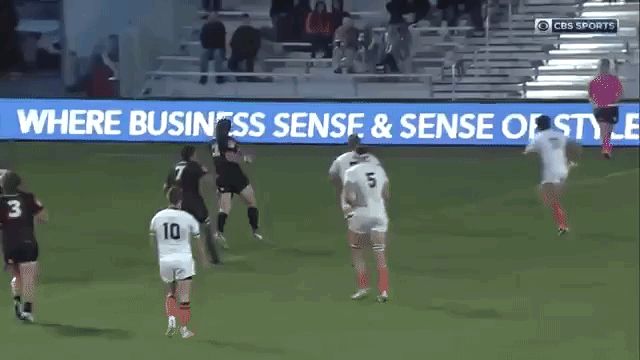
Some big hits can give you an impression he might have been off feet or hasn’t used his hands. I’ve watched, re-winded and taken notes from each and every tackle he’s made
(and missed, as well) during the 2018 MLR season and haven’t found a single illegal tackle.
Incidentally, this is a very good example why rugby has so much to offer in terms of improving tackling efficiency and preventing big plays in football. Rugby players use their
hands. These days that’s a virtue painfully missed on the football pitch. Sorry, football field. The old-school football coaches used to emphasise the four key elements of a successful
tackle: Hit-Wrap-Up-Lift-Drive. The quadruplet’s been reduced lately to just hitting. It’s a spectacular way of tackling, big hits transform into popularity and big money, but ever since
the no-hand tackle became a standard element of defensive backs’ repertoire, missed tackles have plagued the NFL and the NCAAF. To give you a taste of it, here’s the (in)famous missed
tackle from the 2018 playoffs. Had Marcus Williams used his hands, he wouldn’t have
missed Stefon Diggs.
Missed tackles bring me to one aspect of the game that Lasike will need to improve: tackling completion rate. What makes his tackles so spectacular is sometimes what makes him miss the
target. Launching creates the danger of missing the ball carrier, especially in an open-field situation. Below is an example of missed open-field tackle. Watch his feet: you can’t move
your feet whilst launching. And that’s crucial for a successful open-field tackle, when the primary aim is to get closer to the ball carrier.
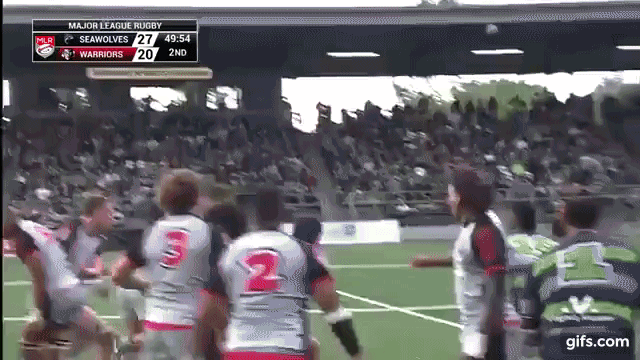
That’s easy to improve by practicing and applying shimmy tackling. By the way, a good deal of great rugby prospects should apply shimmy tackling, too. If you watched the latest World
Rugby U20 Championship, you probably noticed that shimmy tackling could have vastly improved Gabriel Ibitoye’s tackling. I hope next off-season Gabriel will follow Jonny May and spend
some time with American coaches, particularly with special teams coaches. (On second thoughts, I hope he’ll be lifting the trophy on 2. November).
The majority (58%) of the tackles that Paul Lasike missed, however, were due to arm tackling, and that’s more difficult to improve. Attacking a smaller player directly from behind is
challenging for someone who’s six feet tall and weighs nearly 18 stones. The table below breaks down the missed tackles.
| Team |
Ball Carrier |
Position |
Reason for Missing Tackle |
| Houston |
Sam Windsor | FH | arm tackle, tackle too high |
| Glendale (1) |
Harley Davidson | W | arm tackle, tackle too high |
| Seattle |
Phil Mack | SH | arm tackle, tackle too high |
| San Diego |
Anthony Salabar | C | arm tackle, tackle too high |
| Seattle |
Phil Mack | SH | tackle too high |
| Seattle |
#21 | - | tackle too high |
| Austin |
Kyle Breytenbach | N8 | missed ball carrier in the air |
| Glendale (1) |
Chad London | C | missed ball carrier in the air |
| Glendale (1) |
Will Magie | FH | missed ball carrier in the air |
| Seattle |
William Rasileka | C | missed ball carrier in the air |
| San Diego |
Anthony Salabar | C | slipped off ball carrier's leg |
| Glendale (1) |
Harley Davidson | W | slipped off ball carrier's leg |
A few numbers to prove my point. In the second part of the 2017/18 Premiership season, Jamie Roberts’ completion rate was 92.7%. In 9 matches, Jamie missed 7 from 96 tackles.
In a much weaker league, Lassike completed 55 tackles out of total 67 attempts. His completion rate was 10 percentage points below Jamie’s, and that’s something the defence-oriented coaches
would spot immediately.
I also created an interactive
tackling map. Solo, assist, and missed tackles are marked yellow, black, and red, respectively.
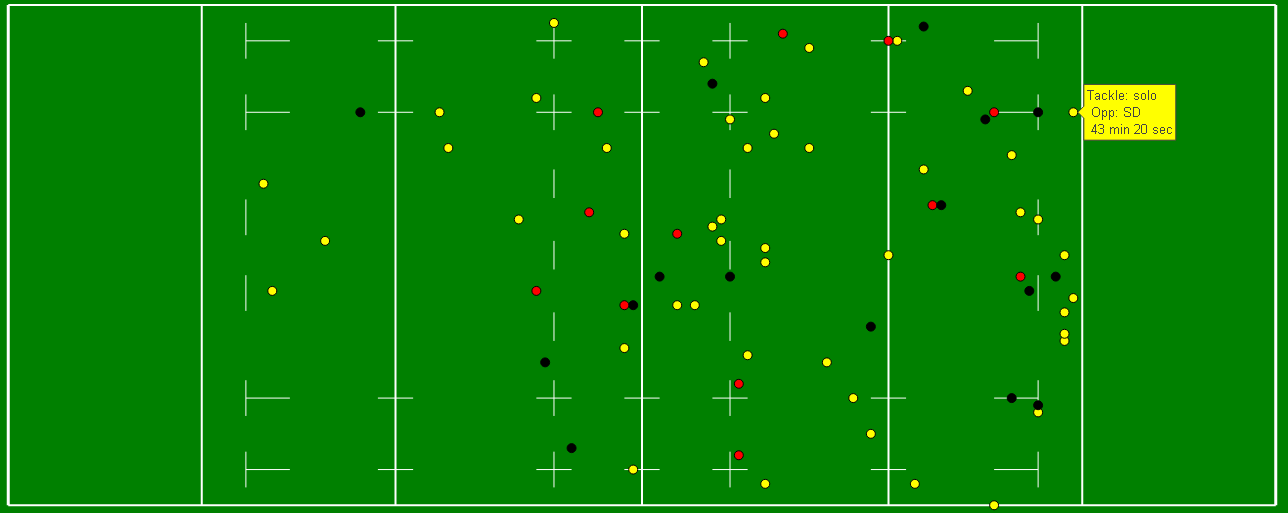
There’s one football defensive statistic that could also be collected for rugby: the hurries. Defensive linemen and linebackers create pressure on the quarterback in order to sack him,
make him run, or forcing him to pass in a hurry. The latter usually ends up with a lighter hit. Does it apply to rugby? The idea is pretty much the same – attack the ball carrier and
force him to pass or make the pass reception as difficult as possible. Here’s an example.
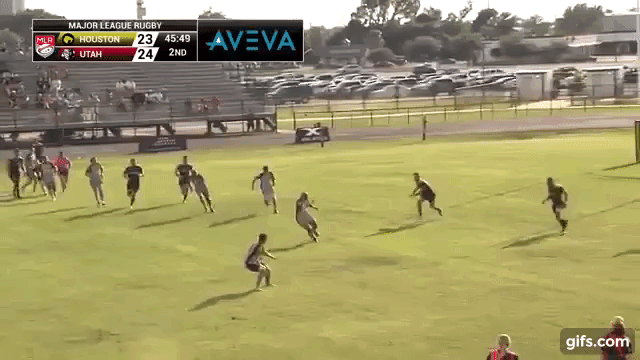
Lasike forces Sabercats fly half Sam Windsor to pass and delivers a light hit. The ball is passed in a hurry, the pass is incomplete, and finally the ball is intercepted. My absolute
favourite example of a hurry was the hit on Scotland centre Ross Deacon, but Wayne Barnes called a knock-on.
Last but not least, Paul Lasike is very effective at rucking and counter-rucking. He’s also a successful jackal. That’s an aspect of the game he can be extremely good at.
Despite his size, he can get very quickly back on his feet after tackling. Here's Paul open-field tackling and recovering the ball and
jackling the ball
Paul Lasike is going to be a solid game changer, very effective on both sides of the ball. I expect his play time to be around 20 min. But as usual, his offensive wrecking-ball
skills will catch the eye more than his defensive performance. Best of luck to him!
You can find his offensive statistics
here
 Here’s another spectacular angle tackle executed in a similar way. Lasike pursues Andrew Suniula and tackles him into touch.
Here’s another spectacular angle tackle executed in a similar way. Lasike pursues Andrew Suniula and tackles him into touch.  Some big hits can give you an impression he might have been off feet or hasn’t used his hands. I’ve watched, re-winded and taken notes from each and every tackle he’s made
(and missed, as well) during the 2018 MLR season and haven’t found a single illegal tackle.
Some big hits can give you an impression he might have been off feet or hasn’t used his hands. I’ve watched, re-winded and taken notes from each and every tackle he’s made
(and missed, as well) during the 2018 MLR season and haven’t found a single illegal tackle.
 That’s easy to improve by practicing and applying shimmy tackling. By the way, a good deal of great rugby prospects should apply shimmy tackling, too. If you watched the latest World
Rugby U20 Championship, you probably noticed that shimmy tackling could have vastly improved Gabriel Ibitoye’s tackling. I hope next off-season Gabriel will follow Jonny May and spend
some time with American coaches, particularly with special teams coaches. (On second thoughts, I hope he’ll be lifting the trophy on 2. November).
That’s easy to improve by practicing and applying shimmy tackling. By the way, a good deal of great rugby prospects should apply shimmy tackling, too. If you watched the latest World
Rugby U20 Championship, you probably noticed that shimmy tackling could have vastly improved Gabriel Ibitoye’s tackling. I hope next off-season Gabriel will follow Jonny May and spend
some time with American coaches, particularly with special teams coaches. (On second thoughts, I hope he’ll be lifting the trophy on 2. November).